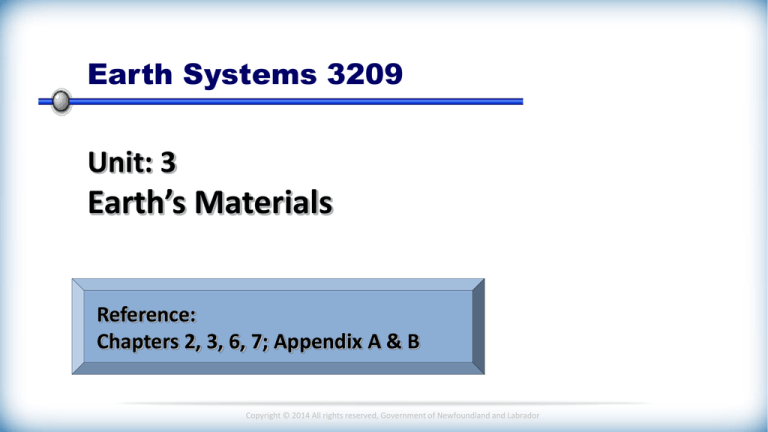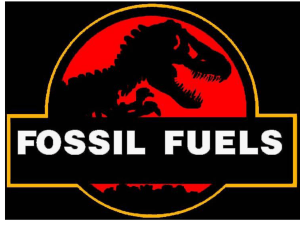
Earth Systems 3209
Unit: 3
Earth’s Materials
Reference:
Chapters 2, 3, 6, 7; Appendix A & B
Copyright © 2014 All rights reserved, Government of Newfoundland and Labrador
Unit 3:
Topic 4.7
Stages of Coal Formation
Focus on . . .
explaining the processes associated with the four
stages responsible for the formation of coal.
Copyright © 2014 All rights reserved, Government of Newfoundland and Labrador
Formation of Coal
Coal is a sedimentary/metamorphic rock produced in
swamps where there is a large-scale accumulation of
organic matter from plants.
Organic materials consist of carbon, oxygen, and hydrogen.
When plant material is buried, the hydrogen and oxygen
(H2O) is released leaving the carbon behind.
Two major coal producing periods are known in geologic
history. During the Carboniferous and Permian Periods,
the continents were apparently located near the equator
and covered by shallow seas.
Text Reference:
This type of environment favoured the growth of
Pages 170-172
vegetation and rapid burial to produce coal.
Copyright © 2014 All rights reserved, Government of Newfoundland and Labrador
Formation of Coal
Coal is considered a Fossil Fuel.
Fossil Fuels:
Non-renewable fuels that formed long ago from the
remains of plants and animals.
The origin of fossil fuels, starts with photosynthesis.
Note that if the reaction runs in reverse, it produces
energy and releases carbon dioxide and water.
Copyright © 2014 All rights reserved, Government of Newfoundland and Labrador
Formation of Coal
The Formation of Coal Involves Several Stages:
1) Formation of Peat:
Swamps are areas where organic matter
from plants accumulate. As the plants die
and get buried they compact to become
peat. With time and more compaction,
almost all of the water is lost and three
different grades of coal result.
Peat is not a rock!! It is a stage of coal.
Copyright © 2014 All rights reserved, Government of Newfoundland and Labrador
Peat
Burial
Lignite Coal Seam
Burial
Formation of Coal
The Formation of Coal Involves Several Stages:
2) Formation of Lignite Coal:
Compaction of the peat due to burial drives
off volatile components like water and
methane, eventually producing a blackcolored, organic-rich coal called lignite.
Soft brown coal which consist of about
40% carbon and a larger amount of volatiles.
Because it has more volatiles, lignite does
not burn efficiently.
Copyright © 2014 All rights reserved, Government of Newfoundland and Labrador
Peat
Burial
Lignite Coal Seam
Burial
Formation of Coal
The Formation of Coal Involves Several Stages:
Burial
3) Formation of Bituminous Coal:
Further compaction and heating results in a
more carbon- rich coal called bituminous
coal.
Compaction
Bituminous
Metamorphism
Soft coal which consist of about 85% carbon
and lesser volatiles.
Burns easily but produces a lot of smoke.
Anthracite Coal
Seam
Copyright © 2014 All rights reserved, Government of Newfoundland and Labrador
Formation of Coal
The Formation of Coal Involves Several Stages:
Burial
4) Formation of Anthracite Coal:
If the rock becomes metamorphosed, a high
grade coal called anthracite is produced.
Hard dark coal which consist of 90% to 95%
carbon and burns very hot and clean. Forms
as a result of metamorphic conditions.
Because it has less volatiles, anthracite coal
burns cleanly produces the most energy.
Copyright © 2014 All rights reserved, Government of Newfoundland and Labrador
Compaction
Bituminous
Metamorphism
Anthracite Coal
Seam
Formation of Coal
Coal
buried and compacted plant material
different kinds of coal, depending on
formation process.
Copyright © 2014 All rights reserved, Government of Newfoundland and Labrador
Stages of Coal Formation
PEAT
LIGNITE
BITUMINOUS
ANTHRACITE
Copyright © 2014 All rights reserved, Government of Newfoundland and Labrador
Example 1:
Which forms by metamorphism?
(A) anthracite coal
(C) sandstone
(B) bituminous coal
(D) shale
In which locality would coal deposits most likely form?
(A) continental shelves
(C) ocean floor
(B) deltas
(D) swamps
Copyright © 2014 All rights reserved, Government of Newfoundland and Labrador
Your Turn . . .
Take the time and complete the following questions . . .
(Solutions to follow)
Question:
What is the correct sequence in the formation of coal?
(A) anthracite - bituminous - lignite - peat
(B) anthracite - peat - bituminous - lignite
(C) peat - anthracite - lignite - bituminous
(D) peat - lignite - bituminous - anthracite
Copyright © 2014 All rights reserved, Government of Newfoundland and Labrador
Solutions . . .
Question:
What is the correct sequence in the formation of coal?
(A) anthracite - bituminous - lignite - peat
(B) anthracite - peat - bituminous - lignite
(C) peat - anthracite - lignite - bituminous
(D) peat - lignite - bituminous - anthracite
Copyright © 2014 All rights reserved, Government of Newfoundland and Labrador
Sample Problem
Use a diagram to explain the four stages involved in
the formation of anthracite coal.
Answer:
From peat to lignite there is burial and compaction.
From lignite to bituminous there is greater burial.
From bituminous to anthracite there is
metamorphism.
Water and gases are released during all stages.
Copyright © 2014 All rights reserved, Government of Newfoundland and Labrador
Summary . . .
Overview of Points covered:
Formation of coal involves four (4) stages:
1) Peat
2) Lignite
3) Bituminous
4) Anthracite
Plant Material
Sedimentary Rock
Metamorphic Rock
Copyright © 2014 All rights reserved, Government of Newfoundland and Labrador








